File Info
| Exam | IBM Storage Technical V1 |
| Number | C9020-668 |
| File Name | IBM.C9020-668.PracticeTest.2019-04-01.73q.vcex |
| Size | 122 KB |
| Posted | Apr 01, 2019 |
| Download | IBM.C9020-668.PracticeTest.2019-04-01.73q.vcex |
How to open VCEX & EXAM Files?
Files with VCEX & EXAM extensions can be opened by ProfExam Simulator.
Coupon: MASTEREXAM
With discount: 20%

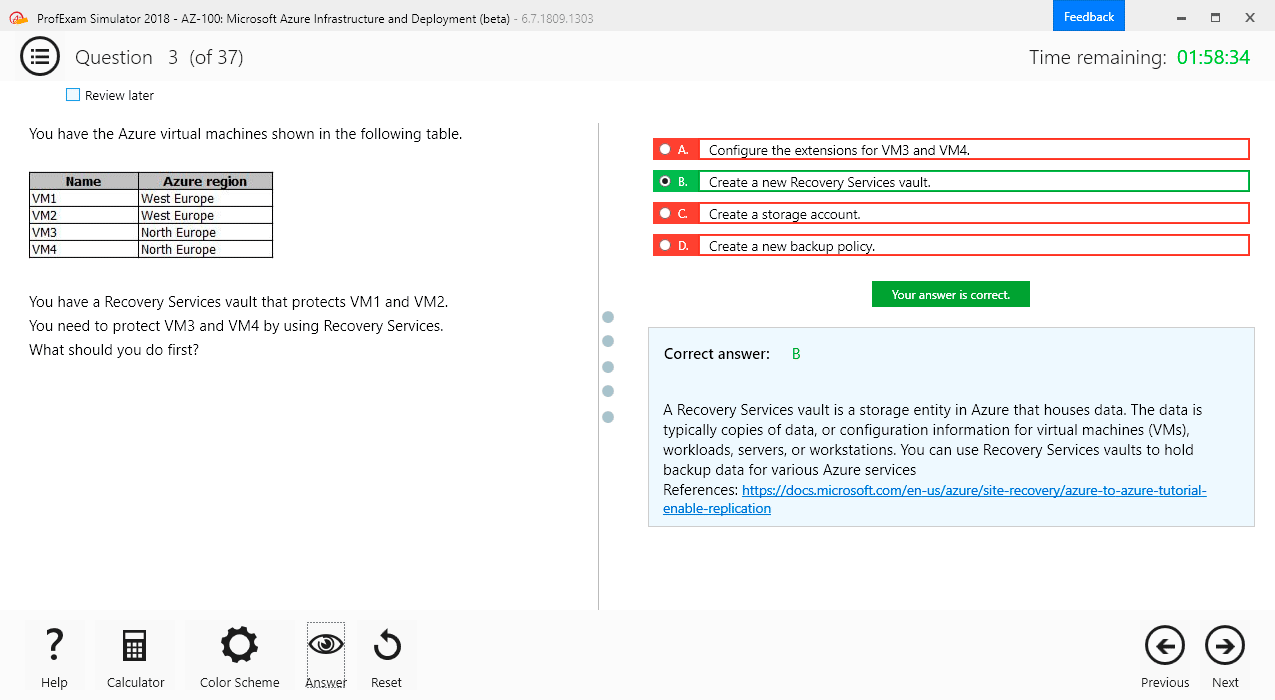
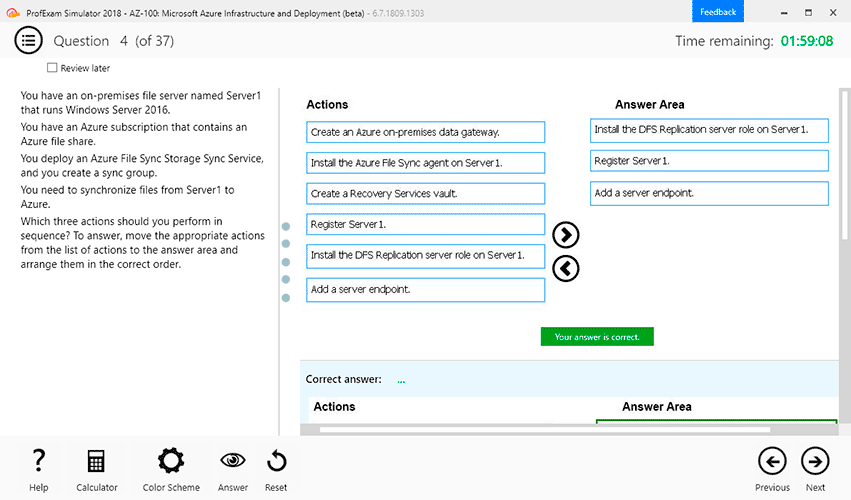
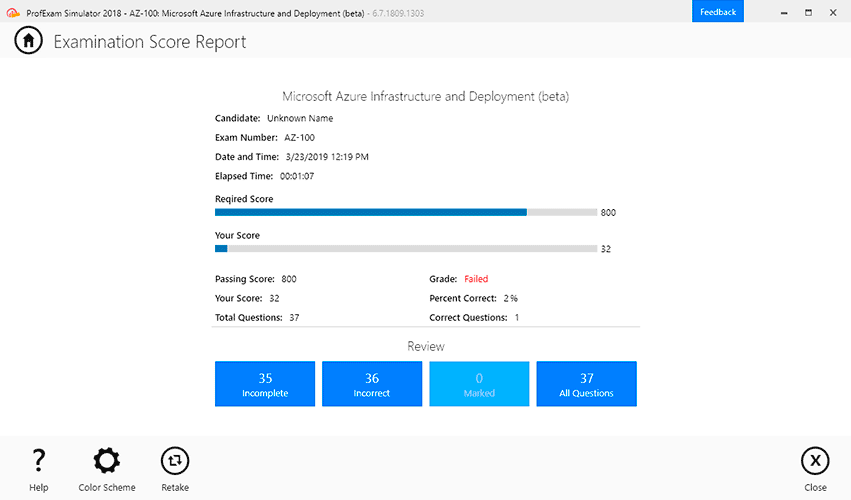
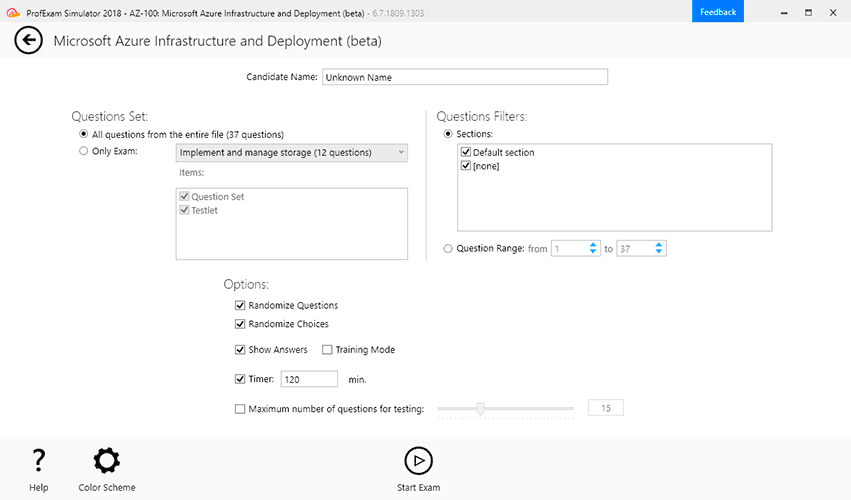
Demo Questions
Question 1
A customer has floor and rack space constraints.
Which model should be included with a single frame IBM TS4500 L25?
- Additional I/O station
- Top rack with PDU
- HD2 storage frame
- Additional cartridge magazines
Correct answer: B
Explanation:
The TS4500 tape library offers high-density (HD), drive-capable and storage-only frame models that are designed to greatly increase storage capacity without increasing frame size or required floor space. The top rack, 3584 Model TR1, provides an extra 10U of rack space on any frame in a library without requiring more floor space. References: https://www.ibm.com/support/knowledgecenter/en/STQRQ9/com.ibm.storage.ts4500.doc/ts4500_library_structure.html The TS4500 tape library offers high-density (HD), drive-capable and storage-only frame models that are designed to greatly increase storage capacity without increasing frame size or required floor space. The top rack, 3584 Model TR1, provides an extra 10U of rack space on any frame in a library without requiring more floor space.
References: https://www.ibm.com/support/knowledgecenter/en/STQRQ9/com.ibm.storage.ts4500.doc/ts4500_library_structure.html
Question 2
Which IBM products should the technical specialist propose to a customer who is using disk-based backups to meet regulatory requirements for low recovery time objectives?
- IBM Spectrum Control Advance
- IBM Spectrum Archive
- IBM Spectrum protect
- IBM Spectrum Control Base
Correct answer: C
Explanation:
IBM Spectrum Protect, formerly Tivoli Storage Manager family, provides backup, snapshot, archive, recovery, space management, bare machine recovery and disaster recovery capabilities. Incorrect Answers:A: IBM Spectrum Control Standard and Advanced Editions are integrated data and storage management software solutions that provides monitoring, automation and analytics for multiple storage systems. B: IBM Spectrum Archive Single Drive Edition features IBM Linear Tape, not disk-based, File System.D: IBM Spectrum Control Base Edition is a centralized cloud integration system that consolidates a range of IBM storage provisioning, virtualization, cloud, automation, and monitoring solutions through a unified server platform. References: https://www.ibm.com/us-en/marketplace/data-protection-and-recovery IBM Spectrum Protect, formerly Tivoli Storage Manager family, provides backup, snapshot, archive, recovery, space management, bare machine recovery and disaster recovery capabilities.
Incorrect Answers:
A: IBM Spectrum Control Standard and Advanced Editions are integrated data and storage management software solutions that provides monitoring, automation and analytics for multiple storage systems.
B: IBM Spectrum Archive Single Drive Edition features IBM Linear Tape, not disk-based, File System.
D: IBM Spectrum Control Base Edition is a centralized cloud integration system that consolidates a range of IBM storage provisioning, virtualization, cloud, automation, and monitoring solutions through a unified server platform.
References: https://www.ibm.com/us-en/marketplace/data-protection-and-recovery
Question 3
Which IBM XIV replication feature provides the ability for a remote target volume to be initialized without requiring the contents of the source volume to be re-replicated over an inter-site link?
- Offline Initialization
- Quick Initialization
- Synchronous Replication
- Asynchronous Replication
Correct answer: A
Explanation:
When an XIV mirror coupling is first activated, all actual data on the source is either copied to the destination (normal initialization) or verified to be on the destination, and only changed data is copied (offline initialization). This process is referred to as initialization. References: https://www.redbooks.ibm.com/redbooks/pdfs/sg247759.pdf, page 83 When an XIV mirror coupling is first activated, all actual data on the source is either copied to the destination (normal initialization) or verified to be on the destination, and only changed data is copied (offline initialization). This process is referred to as initialization.
References: https://www.redbooks.ibm.com/redbooks/pdfs/sg247759.pdf, page 83
Question 4
What is the complete source of information for power, cooling, and floor space requirements for IBM tape products?
- Preinstall TDA checklist
- Product announcement letters
- Installation and Planning Guide
- IBM Storage System Interoperation Center
Correct answer: A
Explanation:
The Technical Delivery Assessment (TDA) pre-installation checklist and worksheets document provides several worksheets that the customer must complete for each XIV system. References: https://www.ibm.com/support/knowledgecenter/en/STJTAG/com.ibm.help.xivgen3.doc/Gen3/PG/xiv_pln3overview.html The Technical Delivery Assessment (TDA) pre-installation checklist and worksheets document provides several worksheets that the customer must complete for each XIV system.
References: https://www.ibm.com/support/knowledgecenter/en/STJTAG/com.ibm.help.xivgen3.doc/Gen3/PG/xiv_pln3overview.html
Question 5
A customer needs to exchange encrypted data cartridges with another company. A competitor offers a solution that encrypts the data with static keys loaded the tape drives. IBM proposes IBM TS1150 tape drives using the built-in encryption feature.
Which competitive advantage does the IBM TS1150 solution provide?
- It achieves better throughput by encrypting and compressing data at the same time.
- It stores keys in the drive that can then be exported to partners in a secure format.
- It compresses the data before encrypting to achieve a better compression ratio.
- it writes a unique encrypted data key on the cartridge using public/private key pairs.
Correct answer: D
Explanation:
How the encryption key server processes encryption keys In system-managed and library-managed tape encryption, unencrypted data (clear text) is sent to the tape drive (TS1150 Tape Drive, TS1140 Tape Drive, TS1130 Tape Drive or TS1120 Tape Drive), and converted to ciphertext using a symmetric 256-bit AES Data Key (DK) generated by the encryption key server. The ciphertext is then written to tape. The encryption key server uses a single, unique Data Key for each Enterprise Tape Cartridge. This Data Key is also encrypted, or wrapped, by the encryption key server using the public key from an asymmetric Key Encrypting Key (KEK) pair. This process creates an Externally Encrypted Data Key (EEDK). The EEDK is written to the cartridge memory and to three additional places on the tape media in the cartridge. The tape cartridge now holds both the encrypted data and the means to decrypt it for anyone holding the private part of the KEK pair. The DK may also be wrapped a second time using the public key of another party to create an additional EEDK. Both EEDKs can be stored on the tape cartridge. In this way, the tape cartridge can be shipped to a business partner holding the corresponding private key. That private key would allow the DK to be unwrapped and the tape decrypted by the business partner. References: https://www.ibm.com/support/knowledgecenter/en/STFS69_3.3.0/ts7740_encryption_keys.html How the encryption key server processes encryption keys
In system-managed and library-managed tape encryption, unencrypted data (clear text) is sent to the tape drive (TS1150 Tape Drive, TS1140 Tape Drive, TS1130 Tape Drive or TS1120 Tape Drive), and converted to ciphertext using a symmetric 256-bit AES Data Key (DK) generated by the encryption key server. The ciphertext is then written to tape. The encryption key server uses a single, unique Data Key for each Enterprise Tape Cartridge. This Data Key is also encrypted, or wrapped, by the encryption key server using the public key from an asymmetric Key Encrypting Key (KEK) pair. This process creates an Externally Encrypted Data Key (EEDK). The EEDK is written to the cartridge memory and to three additional places on the tape media in the cartridge. The tape cartridge now holds both the encrypted data and the means to decrypt it for anyone holding the private part of the KEK pair.
The DK may also be wrapped a second time using the public key of another party to create an additional EEDK. Both EEDKs can be stored on the tape cartridge. In this way, the tape cartridge can be shipped to a business partner holding the corresponding private key. That private key would allow the DK to be unwrapped and the tape decrypted by the business partner.
References: https://www.ibm.com/support/knowledgecenter/en/STFS69_3.3.0/ts7740_encryption_keys.html
Question 6
A customer wants to improve storage efficiency within a data center. The customer requires a low latency storage system that has a highly parallel architecture and comprehensive data reduction with pattern removal.
Which system should the technical specialist propose?
- IBM DS8886 HPFE
- IBM FlashSystem A9000R
- IBM FlashSystem V9000
- IBM XIV with compression
Correct answer: C
Explanation:
IBM FlashSystem A9000 is a highly parallel, all-flash storage solution for cloud-scale businesses:Harness the performance of highly parallel architecture and IBM FlashCore technology in one innovative system Optimize storage economics with pattern removal, deduplication, and compression Incorrect Answers:B: IBM FlashSystem(R) A9000R is a grid-scale, all-flash storage platform.References: https://www-01.ibm.com/common/ssi/rep_ca/7/872/ENUSAG16-0087/ENUSAG16-0087.PDF IBM FlashSystem A9000 is a highly parallel, all-flash storage solution for cloud-scale businesses:
- Harness the performance of highly parallel architecture and IBM FlashCore technology in one innovative system
- Optimize storage economics with pattern removal, deduplication, and compression
Incorrect Answers:
B: IBM FlashSystem(R) A9000R is a grid-scale, all-flash storage platform.
References: https://www-01.ibm.com/common/ssi/rep_ca/7/872/ENUSAG16-0087/ENUSAG16-0087.PDF
Question 7
Which solution provides virtualization, consolidation, and automation for a cloud deployment?
- IBM XIV with IBM Spectrum Protect
- IBM FlashSystem 900
- IBM Virtual Storage Center
- IBM Spectrum Accelerate
Correct answer: C
Explanation:
IBM Virtual Storage Center is a storage virtualization platform and a storage management solution for cloud-based and software-defined storage. Virtual Storage Center enables organizations to monitor, automate and analyze storage. Incorrect Answers:B: IBM FlashSystem 900 all-flash storage arrays accelerate applications in mission-critical environments.D: Use IBM Spectrum Accelerate to build a flexible, cost-effective cloud environment: deploy on any x86 server.References: http://www-03.ibm.com/software/products/en/ibm-virtual-storage-center IBM Virtual Storage Center is a storage virtualization platform and a storage management solution for cloud-based and software-defined storage. Virtual Storage Center enables organizations to monitor, automate and analyze storage.
Incorrect Answers:
B: IBM FlashSystem 900 all-flash storage arrays accelerate applications in mission-critical environments.
D: Use IBM Spectrum Accelerate to build a flexible, cost-effective cloud environment: deploy on any x86 server.
References: http://www-03.ibm.com/software/products/en/ibm-virtual-storage-center
Question 8
A customer looking for an all-flash solution is evaluating IBM products. The primary concern for the customer is rapid growth of its database environment.
Which IBM flash solution should the specialist recommend to control capacity utilization?
- IBM XIV Gen3 with SSD
- IBM DS8886 HPFE
- IBM Flashsystem A9000
- IBM FlashSystem 900
Correct answer: D
Explanation:
IBM FlashSystem 900 is designed to accelerate the applications that drive business – like those using an Oracle Database. IBM FlashSystem 900 can scale usable capacity from as low as 2 TB to as much as 57 TB in a single system. FlashSystem 900 delivers Tier 0 top application performance with up to 1.1 million 100% random read IOPS and 600,000 100% random write IOPS. References: https://www.ibm.com/us-en/marketplace/flash-storage IBM FlashSystem 900 is designed to accelerate the applications that drive business – like those using an Oracle Database.
IBM FlashSystem 900 can scale usable capacity from as low as 2 TB to as much as 57 TB in a single system.
FlashSystem 900 delivers Tier 0 top application performance with up to 1.1 million 100% random read IOPS and 600,000 100% random write IOPS.
References: https://www.ibm.com/us-en/marketplace/flash-storage
Question 9
A customer needs to import and export volumes between IBM Spectrum Virtualize clusters that are geographically separated.
How can this be accomplished?
- Create image mode volumes
- Snapshots with Transparent Cloud Tiering
- Implement IBM Spectrum Archive
- Utilize tiering-to-tape media
Correct answer: B
Explanation:
Transparent cloud tiering is a licensed function that enables volume data to be copied and transferred to cloud storage. The system supports creating connections to cloud service providers to store copies of volume data in private or public cloud storage. With transparent cloud tiering, administrators can move older data to cloud storage to free up capacity on the system. Point-in-time snapshots of data can be created on the system and then copied and stored on the cloud storage. References: https://www.ibm.com/support/knowledgecenter/en/STVLF4_7.8.1/spectrum.virtualize.781.doc/svc_icoverviewtranparentcltier.html Transparent cloud tiering is a licensed function that enables volume data to be copied and transferred to cloud storage. The system supports creating connections to cloud service providers to store copies of volume data in private or public cloud storage.
With transparent cloud tiering, administrators can move older data to cloud storage to free up capacity on the system. Point-in-time snapshots of data can be created on the system and then copied and stored on the cloud storage.
References: https://www.ibm.com/support/knowledgecenter/en/STVLF4_7.8.1/spectrum.virtualize.781.doc/svc_icoverviewtranparentcltier.html
Question 10
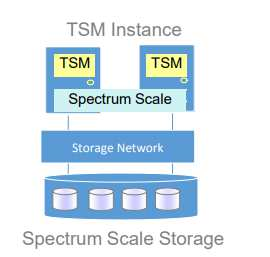
Which component of IBM Spectrum Scale enables data to be imported from several servers at the same time?
- HDFS Transparency connector
- IBM Spectrum Protect integration
- Cloud Object Storage support
- Multi-Cluster feature
Correct answer: B
Explanation:
With Spectrum Scale multiple Spectrum Protect instances use the same storage Capacity and performance management is seamless within a global name space Scalability is seamless and transparent File system replication is integrated with Spectrum Scale for different platforms Central administration of TSM storage Note: Multiple Spectrum Protect (TSM) instances store DB and storage pools in a Spectrum Scale file system (GPFS)Spectrum Scale provides global name space for all Spectrum Protect instances Instances share all file system resources Spectrum Protect instances run on cluster nodes accessing the file system and disk directly Spectrum Scale file systems balances the workload and capacity for all TSM instances on disk Provides standardized, scalable and easy to use storage infrastructure for the multiple instances Incorrect Answers:A: IBM Spectrum Scale HDFS transparency offers a set of interfaces that allows applications to use HDFS Client to access IBM Spectrum Scale through HDFS RPC requests. References: https://www-03.ibm.com/support/techdocs/atsmastr.nsf/5cb5ed706d254a8186256c71006d2e0a/3264fd1e3716c13586257f460072493d/$FILE/SpectrumProtect_on_Spectrum%20Scale_Intro_v6.3.pdf With Spectrum Scale multiple Spectrum Protect instances use the same storage
- Capacity and performance management is seamless within a global name space
- Scalability is seamless and transparent
- File system replication is integrated with Spectrum Scale for different platforms
- Central administration of TSM storage

Note: Multiple Spectrum Protect (TSM) instances store DB and storage pools in a Spectrum Scale file system (GPFS)
- Spectrum Scale provides global name space for all Spectrum Protect instances
- Instances share all file system resources
- Spectrum Protect instances run on cluster nodes accessing the file system and disk directly
- Spectrum Scale file systems balances the workload and capacity for all TSM instances on disk
- Provides standardized, scalable and easy to use storage infrastructure for the multiple instances
Incorrect Answers:
A: IBM Spectrum Scale HDFS transparency offers a set of interfaces that allows applications to use HDFS Client to access IBM Spectrum Scale through HDFS RPC requests.
References: https://www-03.ibm.com/support/techdocs/atsmastr.nsf/5cb5ed706d254a8186256c71006d2e0a/3264fd1e3716c13586257f460072493d/$FILE/SpectrumProtect_on_Spectrum%20Scale_Intro_v6.3.pdf

